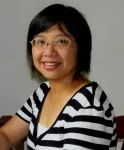Multimodal therapy may hold key to treating aggressive childhood cancer
2021-05-16
(Press-News.org) Research led by scientists at Children's Cancer Institute and published this week in the international journal, Clinical Cancer Research, has found a combination of therapies that appears to be highly effective against high-risk neuroblastoma and other forms of aggressive childhood cancer.
Up to half of all cases of neuroblastoma newly diagnosed in children are 'high-risk', meaning the cancer grows aggressively and is difficult to treat. Despite receiving intensive treatment, most children with high-risk disease die within five years of diagnosis, while those who survive are often left with serious long-term health effects.
Professor Michelle Haber AM, a senior author on the paper and co-head of the Molecular Targets and Cancer Therapeutics theme at Children's Cancer Institute, said children diagnosed with high-risk neuroblastoma have less than a 50-50 chance of survival. "That is a devastating prognosis. We are absolutely determined to find better ways to treat this disease and improve that survival rate."
The research focuses on two different types of therapies, both of which have been found to be effective against high-risk neuroblastoma in the laboratory. The first, CBL0137, is a compound called a curaxin, structurally similar to antimalarial drugs. The second is panobinostat, a new type of compound known as a histone deacetylase inhibitor. In the new research, the scientists tested whether the two therapies could work synergistically when used together, each enhancing the anticancer effect of the other.
The researchers found that the two compounds did indeed work well together, effectively inhibiting the growth of cancer cells in culture, as well as in mice bred to develop human high-risk neuroblastoma. As an added bonus, the therapies also jointly acted to heighten the body's immune response to cancer, which is important since immunotherapy in neuroblastoma is currently challenging.
"In our experiments, we found that the combination of CBL0137 and panobinostat resulted in remarkable growth suppression and an immune response that was tumour-specific," said Professor Haber. "This is very encouraging, because ideally you want a cancer treatment to specifically target cancer cells and leave healthy cells unharmed, reducing the problem of side effects."
Dr Lin Xiao, joint first author and Research Officer in the Experimental Therapeutics Group at the Institute added, "When we used these two compounds together in mice with high-risk neuroblastoma, we saw complete and lasting tumour regression, with minimal ill-effects on the mice. Our results suggest that this combination could work well as a type of immunotherapeutic approach to treating high-risk neuroblastoma."
Further research at Children's Cancer Institute has shown that this type of multimodal therapy is also effective against other high-risk childhood cancers, including some forms of brain cancer. Together, it is hoped these results will lead to a new therapy for aggressive childhood cancer.
INFORMATION:
This work was supported by funding from Cancer Institute NSW, Neuroblastoma Australia, the Kids Cancer Alliance (KCA), Tenix Foundation, Anthony Rothe Memorial Trust, the National Health and Medical Research Council (NHMRC), the Goodridge Foundation, Stanford Brown, Inc (Sydney, Australia), Cancer Council NSW and Tour de Cure.
MEDIA CONTACT:
Children's Cancer Institute contact: Tania Ewing - Phone: 0408 378 422, taniaewing@taniaewing.com
About Children's Cancer Institute
Originally founded by two fathers of children with cancer in 1976, Children's Cancer Institute is the only independent medical research institute in Australia wholly dedicated to research into the causes, prevention and cure of childhood cancer. Forty years on, our vision is to save the lives of all children with cancer and improve their long-term health, through research. The Institute has grown to now employ over 300 researchers, operational staff and students, and has established a national and international reputation for scientific
excellence. Our focus is on translational research, and we have an integrated team of laboratory researchers and clinician scientists who work together in partnership to discover new treatments which can be progressed from the lab bench to the beds of children on wards in our hospitals as quickly as possible. These new treatments are specifically targeting childhood cancers, so we can develop safer and more effective drugs and drug combinations that will minimise side-effects and ultimately give children with cancer the best chance of a cure with the highest possible quality of life. More at http://www.ccia.org.au
ELSE PRESS RELEASES FROM THIS DATE:
2021-05-16
ATS 2021, New York, NY - A weighted "lottery" designed to increase access to the antiviral drug remdesivir during the May-July 2020 COVID-19 surge for those most affected by the coronavirus, including members of the Black, Latinx and indigenous communities, led to more equitable distribution of the badly needed medication, according to research presented at the ATS 2021 International Conference.
At a time when supplies of COVID-19 medications were scarce, Douglas B. White, MD, MAS, vice chair and professor of critical care medicine, UPMC endowed chair for ethics in critical care medicine and director of the Program on Ethics and Decision Making in Critical Illness, University of Pittsburgh School of Medicine, and colleagues, convened ...
2021-05-16
WINSTON-SALEM, N.C. - May 16, 2021 - Heart failure (HF) - when the heart can't pump enough blood and oxygen through the body - affects approximately 6.2 million adults in the United States and is the primary cause of hospitalization in the elderly. Unfortunately, older adults with heart failure often have poor outcomes resulting in reduced quality of life, high mortality and frequent rehospitalizations.
Despite many efforts to improve the prognosis in these patients, most previous studies testing a wide range of interventions were not successful.
Scientists from the Wake Forest, Duke University and Thomas Jefferson ...
2021-05-16
An innovative cardiac rehabilitation intervention started earlier and more custom-tailored to the individual improved physical function, frailty, quality-of-life, and depression in hospitalized heart failure patients, compared to traditional rehabilitation programs. Supported by the National Institute on Aging (NIA), part of the National institutes of Health, these new study results were published May 16 in the New England Journal of Medicine and also presented at the American College of Cardiology's 70th Annual Scientific Session.
"Designing earlier and more personalized individual-specific approaches to heart failure rehab shows great promise for improving outcomes for this common but complex condition that is ...
2021-05-16
The investigational drug evinacumab reduced triglycerides in patients with severe hypertriglyceridemia (sHTG) and a history of hospitalizations for acute pancreatitis in a phase 2 global study led by Mount Sinai. The fully human monoclonal antibody produced sustained reductions in triglyceride levels of up to 82 percent, depending on the patient's genotype, while also lowering the risk of recurrent acute pancreatitis. The results of the study will be presented as a late-breaking clinical trial at the American College of Cardiology (ACC) Annual Scientific Session, on May 16.
"Evinacumab has the potential to not only lower triglycerides, but the risk of acute pancreatitis, quality of life, and the risk of cardiovascular events in ...
2021-05-15
Hamilton, ON (May 15, 2021) - A simple surgery saves patients with heart arrhythmia from often-lethal strokes, says a large international study led by McMaster University.
Researchers found that removing the left atrial appendage -- an unused, finger-like tissue that can trap blood in the heart chamber and increase the risk of clots -- cuts the risk of strokes by more than one-third in patients with atrial fibrillation.
Even better, the reduced clotting risk comes on top of any other benefits conferred by blood-thinner medications patients with this condition are usually prescribed.
"If you have atrial fibrillation and are undergoing heart surgery, the surgeon should be removing your left atrial appendage, because it is a set-up for forming clots. Our trial has shown ...
2021-05-15
Researchers at Rutgers Robert Wood Johnson Medical School are reporting the first instance of COVID-19 triggering a rare recurrence of potentially serious blood clots in people's arms.
The discovery, published in the journal Viruses, improves the understanding of how inflammation caused by COVID-19 can lead to upper extremity blood clots and how best to treat them. The case study is part of a larger Rutgers study of 1,000 hospitalized patients diagnosed with COVID-19 who were admitted and discharged between March and May 2020.
While there have been reports of lower extremity deep vein thrombosis following COVID-19, ...
2021-05-14
Next-generation sequencing technology has made it easier than ever for quick diagnosis of plant diseases. "It's really exciting to see how sequencing technologies have evolved and how this new technology facilitates sequencing of entire genomes in such a short amount of time," said Yazmín Rivera, a plant pathologist with the United States Department of Agriculture's Plant Protection and Quarantine program, who recently published a research paper on the efficacy of Oxford Nanopore Technologies protocols.
"We wanted to provide an unbiased assessment of the technology and protocols available for long read sequencing," Rivera explained. Along with other plant pathologists, Rivera used the company's protocols to prepare RNA and DNA libraries from virus-infected plant material ...
2021-05-14
People with a high polygenic risk score for colorectal cancer could benefit more at preventing the disease by leading healthy lifestyles than those at lower genetic risk, according to a study by Vanderbilt researchers published in the April issue of The American Journal of Clinical Nutrition.
Analyzing data from participants in the UK Biobank, the researchers estimated that maintaining a healthy lifestyle was associated with a nearly 40% reduction in colorectal cancer risk among those with a high genetic risk of developing the disease. The percentage dropped to only about 25% among people at ...
2021-05-14
Dozens of commonly used drugs, including antibiotics, antinausea and anticancer medications, have a potential side effect of lengthening the electrical event that triggers contraction, creating an irregular heartbeat, or cardiac arrhythmia called acquired Long QT syndrome. While safe in their current dosages, some of these drugs may have a more therapeutic benefit at higher doses, but are limited by the risk of arrhythmia.
Through both computational and experimental validation, a multi-institutional team of researchers has identified a compound that prevents the lengthening of the heart's electrical event, or action potential, resulting in a major step toward safer use and expanded therapeutic efficacy of these ...
2021-05-14
Extracting hydrogen from water through electrolysis offers a promising route for increasing the production of hydrogen, a clean and environmentally friendly fuel. But one major challenge of water electrolysis is the sluggish reaction of oxygen at the anode, known as the oxygen evolution reaction (OER).
A collaboration between researchers at Hunan University and Shenzhen University in China, has led to a discovery that promises to improve the OER process. In their recent paper, published in the KeAi journal Green Energy & Environment, they report that etching - or, in other words, chemically removing - the oxide overlayers that form on the surface of the metal phosphide electrocatalysts regularly used in electrolysis, can increase ...
LAST 30 PRESS RELEASES:
[Press-News.org] Multimodal therapy may hold key to treating aggressive childhood cancer



